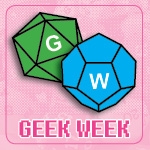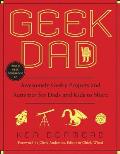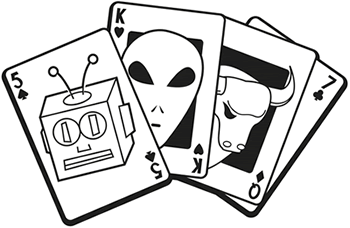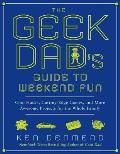

Sometimes big board games can be a little overwhelming for younger gamers. That's why card games can be so engaging for kids. But after the thousandth game of War, parents may yearn for something a little more interesting. It also wouldn't hurt if you didn't have to go out and buy every last foil-wrapped packet of the latest combat card game to find that one special card. So, in the same vein as my DIY board game project, let me offer you an idea for making your own card game, which can combine the fun and craftiness of designing it together with the satisfying sense of ownership that comes from doing it yourself.
The idea for this project came from my good friend "Z," senior editor at GeekDad and longtime podcast partner. It's detailed in my second book, The Geek Dad's Guide to Weekend Fun, but I'm happy to outline it here so folks can try it with their families for International TableTop Day.
This is a game for 2-4 players using one customized deck of playing cards. If you want to work with a larger group, add additional decks as needed. And if you have experience with combat card games, feel free to expand or alter these rules to make the game more challenging and fun for yourselves.
Step 1: Build the Deck
 |
| Illustration by Ken Denmead |
Take a standard deck of playing cards and remove the jokers (which may be used later for alternate rules variants). Now separate the face cards from the rest of the deck. Divvy up the face cards among your players and start customizing them.
By customizing, I mean drawing on the cards, putting stickers on them, doing whatever you like to make them not just playing cards but COOL COMBAT CARDS. What's the theme for your combat game? Is it robots? Dragons? Animals? Aliens? It's up to you what you put on the cards, just as long as you make sure the suit is still obvious and you don't alter the backs. These customized face cards will become the Character Cards, the warriors battling for supremacy on the Playing Surface.
Step 2: Set Up the Game
Shuffle the Character Cards and deal two cards to each player, who should then place the cards faceup in a row in front of them. With each player's Character Cards in place, the remaining Character Cards and the Number Cards should be shuffled and placed in a common Draw Deck between the players. Each player should draw a single card from the Draw Deck, then the highest number card drawn will go first, with play progressing clockwise from that player. With the play order now decided, place the used cards facedown to one side of the Draw Deck to begin the Discard Pile.
Step 3: Play the Game
Each round, a player selects a single card from the Draw Deck. The player then has four options:
- Use an Attack Card: The player may use a red Number Card (heart or diamond) to attack an opponent's black Character Card (club, spade) or use a black Number Card to attack a red Character Card, for damage points equal to the attacking Number Card's value. Each Character Card is understood to have 11 Hit Points, and any attached Attack Cards will be stacked faceup below the attacked Character Card to represent damage. After a Character Card has accrued 11 points of damage, its Hit Points have been exhausted, and the card is flipped over to denote that it is out of play (and any attached Attack Cards are placed facedown in the Discard Pile). If at any time a player has no Character Cards in play, he/she is out of the game.
- Use a Buff Card: The player may use a red or black Number Card to buff (or heal) one of his own red or black Character Cards restoring Hit Points equal to the Number Card's value. Buffs may be applied only to damaged Character Cards, and recovered Hit Points — represented by the Buff Cards being stacked faceup above the Character Card — may never exceed the original 11. If a Character Card is taken out of play, these Buff Cards are also placed facedown in the Discard Pile.
- Pass: The player may simply add the drawn card to his/her hand (with the face value concealed from other players), take no further action, and pass clockwise to the next player.
- Call for Reinforcements: Should the player draw or have in hand a Character Card, he/she may place it faceup on the table adjacent to his/her other Character Cards, thus supplementing his/her defenses.
 Play continues until only one player has in-play Character Cards remaining, and that player is declared the winner of the Playing Surface. Should game play exhaust the Draw Deck before a winner is determined, the cards from the Discard Pile may be shuffled and recycled as the new Draw Deck.
Play continues until only one player has in-play Character Cards remaining, and that player is declared the winner of the Playing Surface. Should game play exhaust the Draw Deck before a winner is determined, the cards from the Discard Pile may be shuffled and recycled as the new Draw Deck.
Points of Clarification:
- The total Hit Points of a Character Card at any given time is equal to 11 minus the sum of the values of attached Attack Cards, plus the sum of the values of attached Buff Cards.
- Total Hit Points for a Character Card cannot exceed 11 in the standard game.
- Character Cards cannot be brought back into play in the standard game.
Optional Rules:
- Jokers may be included and used as Hyper Buffs capable of resurrecting out-of-play Character Cards. Once used, Jokers are treated just like Character Cards in that they are flipped facedown and not returned to the Discard Pile.
- For more advanced play, Character Cards may be healed only by matching suit Buff Cards rather than matching color.
- Alternately, matching suit Buff Cards may be allowed to heal a Character Card above the 11-point limit for a temporary time period (perhaps one or more rounds).
If you and your kids have some experience with how the traditional CCGs work, you can take this game even further, allowing for certain card types to do more damage than others. Or you can have special defense cards that each player hides facedown under a Character Card, which will absorb damage from a specific Attack Card (only even-number hearts, odd-number clubs, prime numbers) or even trigger an out-of-turn attack on another player. The possibilities are as endless as your imaginations.
More from Ken Denmead on PowellsBooks.Blog: